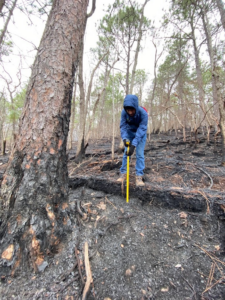
Kathleen Gabler
Decades of fire exclusion have left montane longleaf pine ecosystems with accumulated fuel loads, creating challenges for land managers looking to restore these fire-dependent landscapes. Kathleen Gabler, a forestry doctoral candidate in the Auburn University College of Forestry, Wildlife and Environment (CFWE), is investigating how different tree species influence fuel accumulation and fire behavior. Her research, funded by the Joint Fire Science Program’s (JFSP) Graduate Research Innovation (GRIN) Award, aims to offer critical insights regarding how variations in fuel composition affect fire intensity and tree mortality, helping land managers develop more effective strategies for using prescribed fire.
The GRIN Award supports graduate students conducting innovative fire-related research to address fire management challenges and advance fire science. By understanding these dynamics, Gabler’s work offers practical guidance for restoring ecosystem function while minimizing damage to mature trees.
Tree species influence on fire behavior and fuel accumulation in ecosystems
Gabler’s research specifically examines how various tree species create “zones of influence” that can alter the composition and characteristics of the duff and litter layers surrounding them. These organic layers are found on the bottom of the forest floor and play important roles in the forest ecosystem. Alterations in these layers can potentially lead to differences in fire intensity and smoldering behavior, which are crucial factors in managing prescribed fires.
Taking an innovative approach to this type of research, Gabler combines observational studies with small-scale experimental burns to assess the effects of fuel accumulation around trees of varied species. Her detailed measurements of duff and litter accumulation at varying distances from tree bases, alongside analyses of fire behavior, provide a comprehensive assessment of how fire severity varies with fuel accumulation and tree types.
“This research aims to achieve a better understanding of how different tree species influence fuel accumulation and fire behavior in long-unburned montane longleaf pine ecosystems,” Gabler said.
Her goal is to fill a critical gap in the understanding of fire reintroduction in fire-excluded montane longleaf pine systems. By providing a deeper understanding of how fuel composition and tree species interact with fire behavior, her work helps ensure that fire reintroduction efforts are both safe and collaborative. Gabler’s findings are poised to improve knowledge-sharing and collaboration among land managers, promoting the development of more informed fire management practices.
Improving fire management for longleaf pine ecosystem restoration

An observational study with a small-scale experimental burn to assess the effects of fuel accumulation around trees.
Prescribed fire research is pivotal to the restoration of longleaf pine ecosystems, supporting the reduction risks associated with uncontrolled wildfires. By improving fire management strategies, Gabler’s work also contributes to carbon conservation by preserving mature trees which store carbon and enhance ecosystem resilience and function. Additionally, the insights gained from this study will help optimize the cost-effectiveness of fire management practices, providing land managers with data that can inform more sustainable and efficient restoration efforts.
“Gabler’s research not only advances scientific understanding of fire dynamics in longleaf pine ecosystems but also offers actionable solutions for land managers facing the complex challenges of fire reintroduction,” said Heather Alexander, Gabler’s academic advisor, and the Dwain G. Luce Endowed Associate Professor of forest ecology. “Her work is integral to the long-term health and productivity of these ecosystems, supporting both environmental conservation and the economic vitality of local communities.”
By improving fire management practices, Gabler says her research will contribute to the broader goal of ecosystem restoration and the protection of vital timber resources.
“This understanding is crucial for developing more effective fire management practices, particularly in fire-dependent ecosystems,” Gabler said. “By informing prescribed burn practices, this research helps maintain ecosystem resilience and function, reducing the likelihood of catastrophic fire events.”









